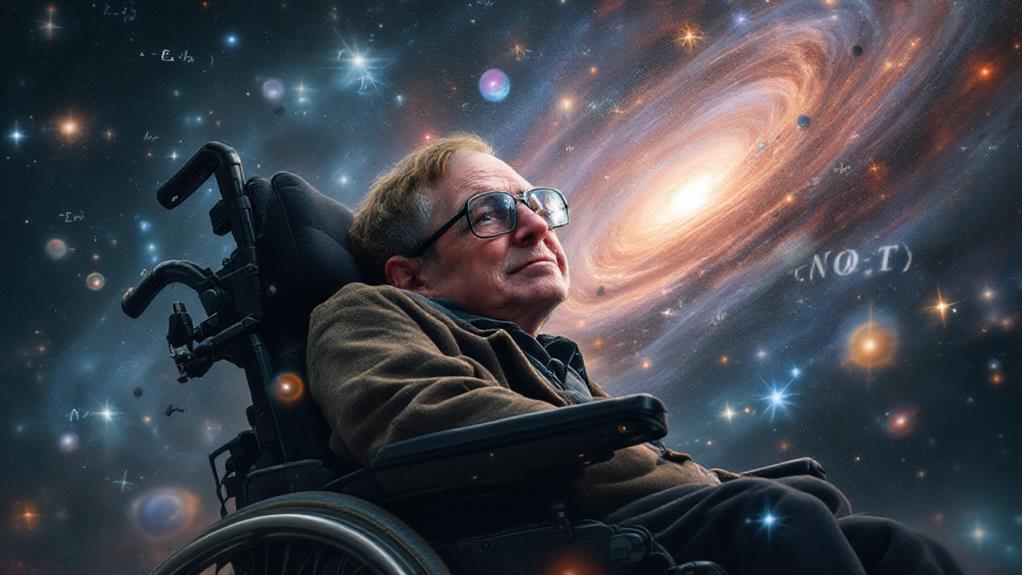20 Fascinating Facts About Albert Einstein: The Genius Behind Relativity
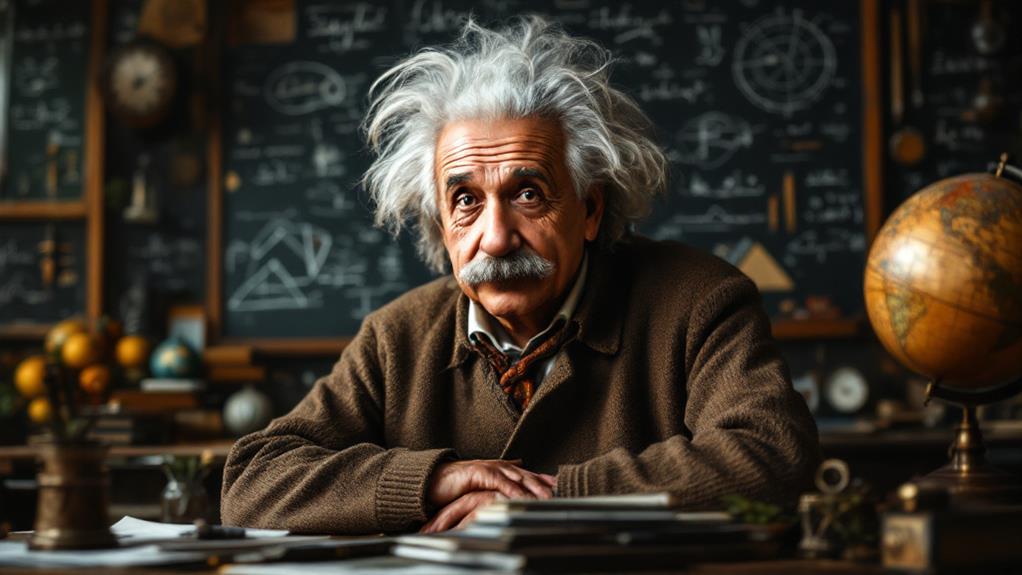
You're in for a treat with 20 intriguing facts about Albert Einstein, who wasn't just a genius in physics but a mesmerizing personality. He faced setbacks in school due to his unconventional learning style, yet thrived in the Swiss Patent Office where he found the stability to develop his groundbreaking theories. Einstein's special relativity challenged Newtonian physics and his famous E=mc² equation showed the profound relationship between energy and mass. Awarded the Nobel Prize for his work on the photoelectric effect, he left a lasting impact. Explore further and uncover how Einstein's legacy continues to inspire and fascinate.
Early Struggles in School
Albert Einstein, often celebrated for his genius, faced surprising challenges during his school years. You might find it hard to believe, but Einstein encountered significant learning difficulties early on. His mind didn't always align with the conventional teaching methods of his time. Instead, he thrived on unconventional methods, which often led to misunderstandings with teachers and peers. These academic setbacks sometimes painted him as a poor student, but his early interests in science and philosophy hinted at the brilliance to come.
Social challenges also marked Einstein's schooling. He didn't easily connect with classmates, leading to strained peer relationships. This social isolation, however, fueled his personal motivation to explore deeper into subjects he loved, like math and physics. Despite these hurdles, certain educational influences, such as exposure to classical music and critical thinking discussions, ignited his intellectual curiosity. These influences helped compensate for the rigid school structure he found stifling.
Einstein's ability to overcome these early struggles showcases his resilience. His path through academic setbacks and social challenges didn't deter him; instead, they shaped his unique approach to problem-solving, laying the groundwork for his future breakthroughs in science.
The Patent Office Years
During his time at the Swiss Patent Office, Einstein's creativity and analytical skills found fertile ground. Working as a technical expert, he reviewed patent innovations daily. His job required a keen eye and the ability to scrutinize complex technical details, a task that sharpened his problem-solving abilities. By evaluating ingenious inventions, he honed his analytical thinking, a skill that would later prove crucial in his scientific breakthroughs.
Each day, his routine involved examining a variety of patent applications. From electrical signals to mechanical devices, these innovations provided him with a constant source of inspiration. This exposure to cutting-edge technologies allowed him to stay updated on the latest advancements, fueling his imagination and curiosity. While his work might have seemed mundane to others, Einstein found it intellectually stimulating.
The structured environment of the patent office also offered him the freedom to ponder his scientific ideas. With fixed working hours and minimal stress, he could dedicate evenings and weekends to his theoretical pursuits. This balance of routine and intellectual exploration gave Einstein the perfect backdrop to refine his thoughts and lay the groundwork for future scientific endeavors.
Birth of Special Relativity
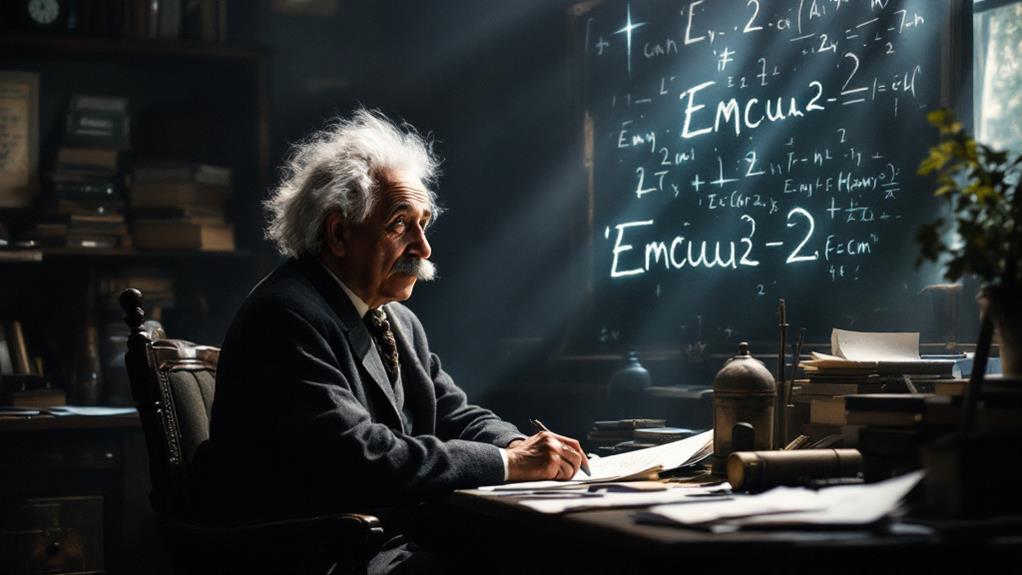
How did the revolutionary idea of special relativity come to be? Imagine you're Albert Einstein, working in a Swiss patent office. It's 1905, and you're pondering the nature of light and time. Unlike others, you dare to question established physics. Your curiosity leads to investigating how the speed of light remains constant regardless of the observer's motion. This bold thought ignites the theory development for special relativity.
During this period, you're not alone in your quest. Scientific collaboration plays an essential role. You exchange ideas with colleagues like Michele Besso, a fellow physicist and close friend. These discussions sharpen your thinking, allowing you to refine and solidify your groundbreaking theory. Your creativity thrives as you challenge traditional concepts.
Here are key aspects that fueled the birth of special relativity:
- Questioning Assumptions: You didn't accept Newtonian physics at face value.
- Thought Experiments: Visualizing scenarios helped you investigate complex ideas.
- Collaborative Discussions: Conversations with peers sparked new insights.
- Analyzing Light's Behavior: Understanding light's speed was central to your theory.
- Breaking Conventions: You weren't afraid to challenge scientific norms.
With these elements, you paved the way for a new understanding of how time and space intertwine.
E=mc² Explained
As you investigate Einstein's iconic equation, E=mc², you'll uncover the profound relationship between energy (E), mass (m), and the speed of light (c). This elegant formula illustrates the concept of energy equivalence and reveals that mass and energy are interchangeable. Simply put, mass can be converted into energy and vice versa. The "c" in the equation represents the speed of light, which is an immense value—approximately 299,792,458 meters per second. Because "c" is squared in the equation, even a small amount of mass can be converted into a large amount of energy.
When you grasp the implications of E=mc², you realize that mass conversion is a fundamental aspect of how the universe operates. For example, in nuclear reactions, a small amount of mass disappears, transforming into a significant amount of energy. This principle is what powers the sun, where hydrogen atoms fuse to form helium, releasing tremendous energy in the process.
Understanding E=mc² also highlights the interconnectedness of the universe. It emphasizes that everything, from the tiniest particle to the vast expanse of the cosmos, is bound by the same principles of energy and mass, forever transforming and interacting.
Nobel Prize for Physics
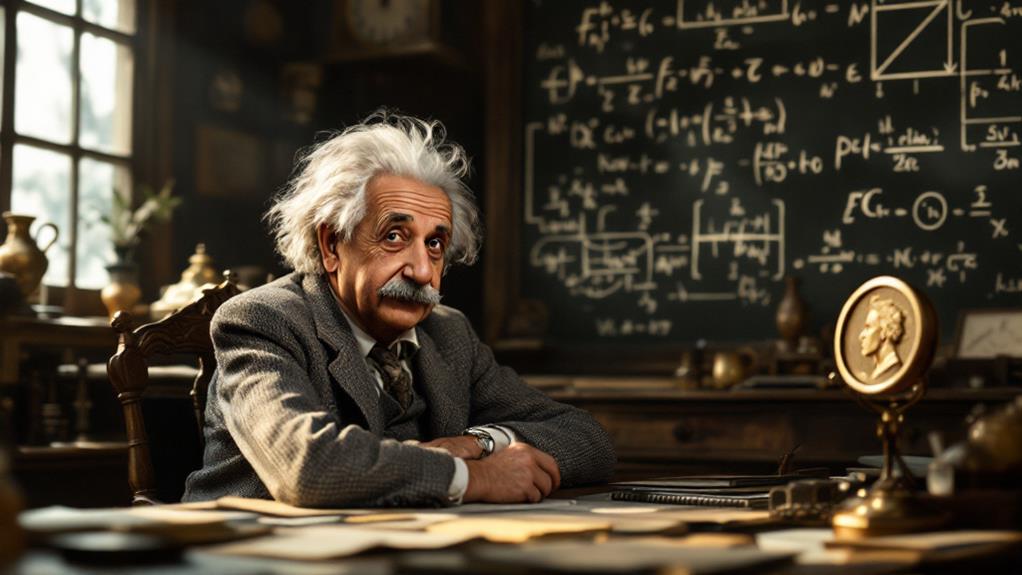
Albert Einstein's contributions to physics are monumental, but it's his 1921 Nobel Prize for Physics that stands as a tribute to his groundbreaking work. Instead of recognizing his theory of relativity, which many anticipated, the Nobel committee awarded him for his Nobel contributions to the photoelectric effect. This was a crucial revelation that helped establish quantum theory, demonstrating that light behaves as both a wave and a particle. This insight not only transformed physics but also paved the way for modern technologies like solar panels and digital cameras.
The Prize significance goes beyond honoring Einstein's individual achievement. It highlights the broader impact of his work on technology and scientific understanding. Here are a few points to reflect on:
- Photoelectric Effect: Showed that light can eject electrons from a material.
- Quantum Theory Foundation: Provided a basis for quantum mechanics.
- Technological Impact: Influenced the development of numerous electronic devices.
- Scientific Recognition: Cemented Einstein's status among the greatest physicists.
- Nobel Legacy: Inspired future research in quantum physics.
Pacifist and Humanitarian
Einstein's scientific achievements didn't just shape the world of physics; they also influenced his views on humanity and peace. He believed that his intellectual gifts came with a responsibility to advocate for the greater good. This belief drove him into peace activism, where he used his platform to speak against war and violence. In a world marred by conflict, he tirelessly promoted disarmament and diplomacy. Einstein's ethical philosophy was grounded in the conviction that humanity must prioritize compassion and understanding over aggression.
As a pacifist, you'd find Einstein regularly voicing opposition to militarization. He famously signed the 1922 manifesto against compulsory military service and joined the League of Nations' Committee on Intellectual Cooperation, which aimed to foster international dialogue and prevent war. Despite his stance, Einstein's views evolved when faced with the rise of fascism, yet his commitment to humanitarian causes remained steadfast. He supported civil rights, aligning with leaders like W.E.B. Du Bois, and spoke out against racism and segregation. By engaging with global issues, Einstein demonstrated that his genius wasn't confined to theoretical physics—it extended to inspiring a more peaceful and equitable world.
Escape From Nazi Germany
In the early 1930s, the growing threat of Nazi Germany forced many intellectuals and scientists, including Einstein, to make difficult decisions about their safety. For Einstein, the rise of Nazi persecution was a clear sign that his time in Germany had come to an end. As a prominent Jewish scientist, he became a target for anti-Semitic propaganda. His emigration expedition was not just a personal decision but a necessary move to guarantee his safety and continue his work.
Einstein's escape was both strategic and urgent. He left Germany in December 1932, just weeks before Adolf Hitler's rise to power. His voyage symbolized not just his escape, but the broader exodus of intellectual talent from Europe due to Nazi oppression.
Consider these points about Einstein's escape:
- He renounced his German citizenship in protest against the regime.
- Einstein settled in the United States, where he accepted a position at the Institute for Advanced Study in Princeton.
- His move was facilitated by friends and colleagues who recognized the dangers he faced.
- Einstein's departure highlighted the loss of intellectual capital due to Nazi persecution.
- His emigration expedition was a demonstration of resilience and the pursuit of scientific freedom.
Love for Music and Violin
Renowned for his contributions to physics, Einstein also had a profound love for music, especially the violin. Music wasn't just a pastime for him; it was a source of inspiration and comfort. You might find it interesting that Einstein began playing the violin at the stage of six, influenced by his mother, Pauline, who was an accomplished pianist. This early musical influence set the stage for a lifelong passion.
Einstein's approach to the violin was as careful as his scientific pursuits. He wasn't just about playing notes; he worked tirelessly on his violin technique, working to master the instrument. He believed that music helped him think and solve complex problems. Often, when he faced a challenging scientific dilemma, he'd retreat to his beloved violin. Playing the instrument allowed his mind to wander freely, often leading to breakthroughs in his work.
He adored composers like Mozart and Bach, whose works he played frequently. Their compositions resonated with him, reflecting the harmony and beauty he sought in his scientific theories. Even in his later years, Einstein continued to perform in private gatherings, sharing his love for music with friends and family.
Quirky Fashion Sense
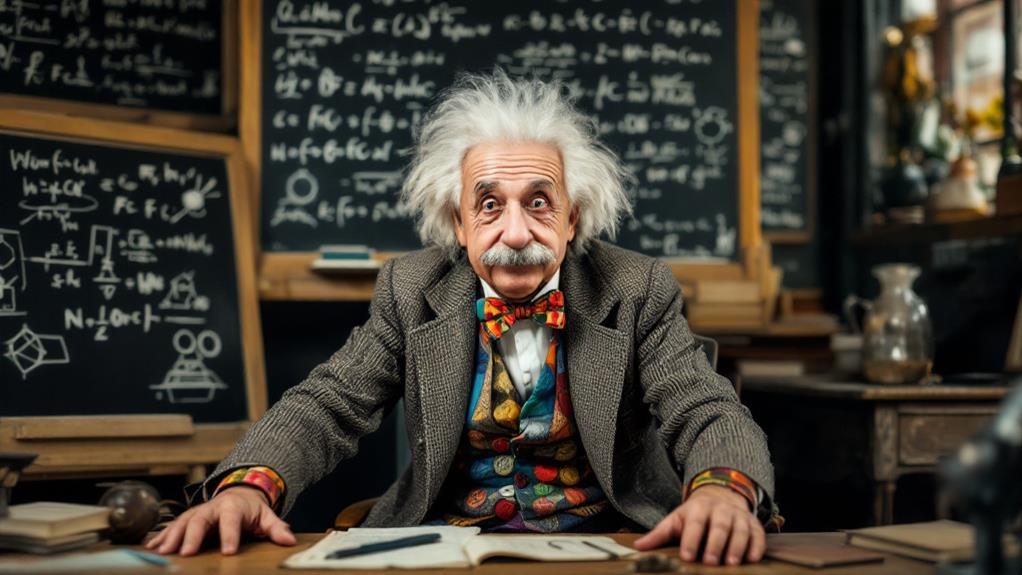
Many are captivated by Albert Einstein's unique fashion choices that set him apart from his contemporaries. His style was a blend of practicality and eccentricity, reflecting his brilliant mind. You'd often find him wearing a disheveled look, famously avoiding socks due to their propensity to develop holes, a quirk he accepted wholeheartedly. His fashion evolution showcased his disregard for societal norms, prioritizing comfort over conformity.
Einstein's wardrobe was simple yet distinguished by eccentric accessories. He'd often opt for:
- Baggy suits: Prioritizing comfort, these were his go-to choice.
- Sweaters: Even in formal settings, adding a casual touch.
- Sandals: A preference for ease, sometimes even with his suits.
- Wide-brimmed hats: Providing him a distinct silhouette.
- Unkempt hair: Almost a fashion statement in itself.
These choices weren't just about personal comfort; they were emblematic of his independent thinking. You can see how his fashion sense mirrored his intellectual pursuits—unconventional and unbound by traditional expectations. His attire, much like his scientific theories, challenged the accepted norms, inspiring a fashion evolution that highlighted individuality. When you think of Einstein, it's not just his genius in relativity, but also his memorable sartorial flair.
The Manhattan Project Stance
Albert Einstein grappled with the moral implications of the Manhattan Project, a vital moment in history. As you investigate this aspect of his life, you'll uncover that Einstein's ethics played a significant role in his stance. Though he didn't directly participate in building the atomic bomb, his famous letter to President Roosevelt in 1939, co-signed with physicist Leo Szilard, highlighted the potential threat posed by Nazi Germany's pursuit of nuclear weapons. This letter spurred the U.S. into action, leading to the eventual development of the Manhattan Project.
Once the bomb was used, Einstein's perspective shifted. He regretted his involvement and advocated for international control of nuclear weapons, emphasizing peace and scientific collaboration rather than destruction. This period showcased his deep moral convictions and his commitment to ethical responsibility in science. You can see how Einstein's ethics influenced his later life, as he became an outspoken advocate for disarmament and global cooperation. His actions during this time reflect the complexity of balancing scientific advancement with moral and ethical considerations, highlighting the significance of responsible scientific collaboration in addressing humanity's most pressing challenges.
Citizenship and Identity
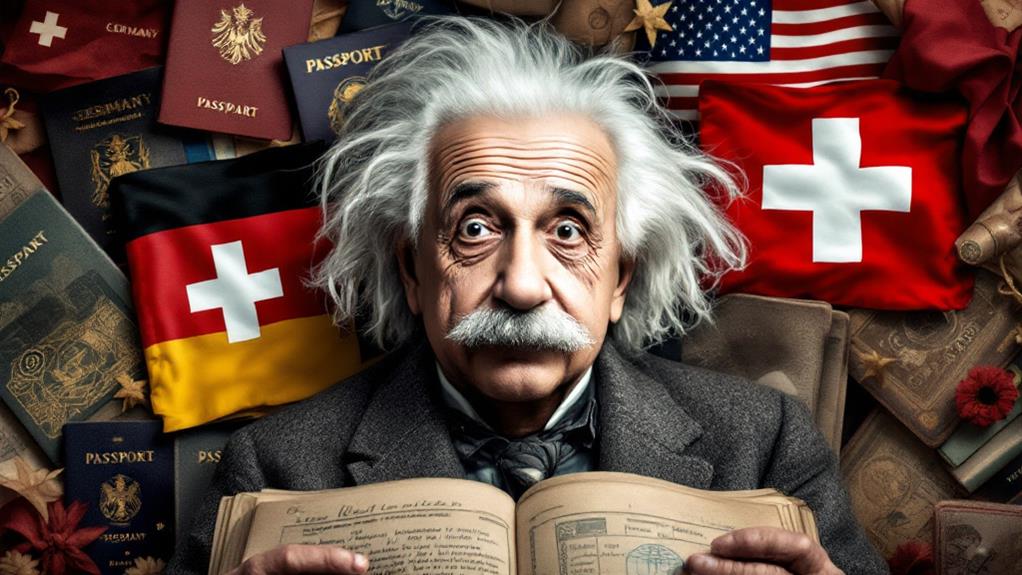
Despite being born in Germany, Albert Einstein's citizenship and identity underwent significant transformations throughout his life. Initially, you might think of Einstein as quintessentially German, but his story reflects a more complex and multifaceted identity. At the milestone of 16, he renounced his German citizenship to avoid military service. Shortly afterward, he found a new home in Switzerland, where he accepted his Swiss identity. This change marked a crucial moment in his life, providing him stability and fostering his academic pursuits.
Einstein's expedition didn't stop there. Here are some key points about his citizenship and identity:
- He became a Swiss citizen in 1901, which he considered a significant aspect of his identity.
- Despite his Swiss identity, he briefly regained German citizenship in 1914 when he accepted a position in Berlin.
- In 1933, Einstein renounced his German citizenship again due to the rise of the Nazi regime.
- He settled in the United States, becoming an American citizen in 1940.
- Throughout his life, Einstein often identified more with a sense of global citizenship, advocating for international peace and cooperation.
Einstein's shifting citizenship highlights his adaptability and complex identity, transcending national boundaries.
Passion for Sailing
Gliding over the serene waters, Einstein found comfort and inspiration in his passion for sailing. When you picture him, tangled in thought and equations, it's easy to overlook this facet of his life. Yet, the gentle rhythm of the waves and the quietude of the sea offered respite from his intellectual pursuits. His sailing adventures weren't just a pastime; they were a profound escape that enriched his mind and spirit.
Einstein often sailed on Lake Geneva and Long Island Sound, places where he could submerge himself in the vastness of nature. Despite being notoriously poor at navigation—he couldn't swim and often relied on others to rescue him when he drifted too far—his love for the sport never wavered. It was on these waters that he developed his own nautical philosophy, where the simplicity of the boat contrasted with the complexity of his thoughts.
You might find it surprising that Einstein's approach to sailing mirrored his scientific endeavors. He welcomed uncertainty and the unpredictable nature of the elements, much like the challenges he faced in theoretical physics. His passion for sailing, though seemingly unrelated, was integral to the genius behind relativity.
Letters With Sigmund Freud
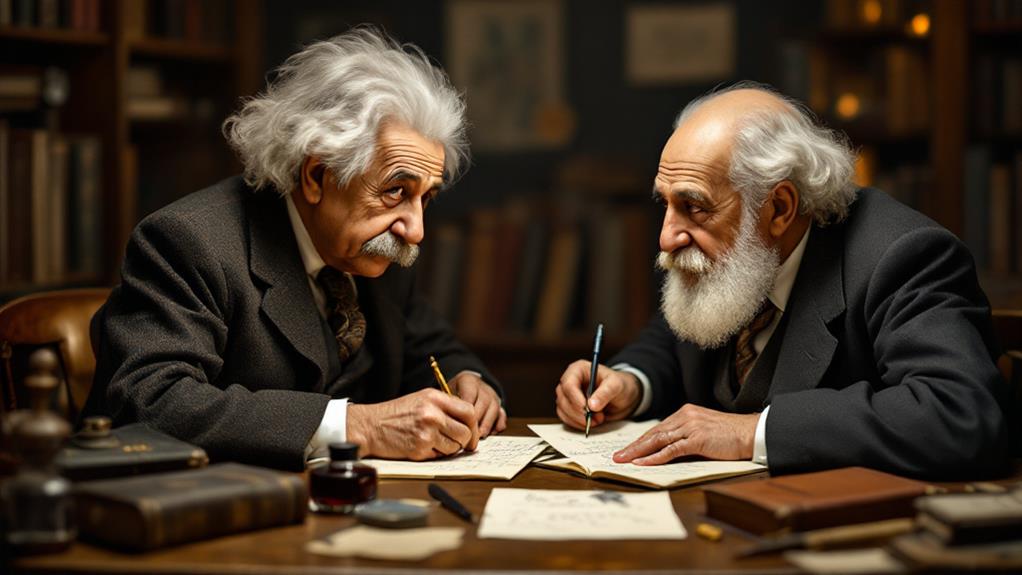
Einstein's passion for sailing wasn't his only unconventional pastime; he also engaged in an intellectual exchange with another prominent thinker of his time, Sigmund Freud. Their correspondence began in 1931, driven by a shared curiosity about the nature of war and human aggression. While Einstein was deeply rooted in the world of physics, he ventured into the domain of psychological theories to investigate the underlying causes of conflict.
Their letters, part of an intellectual correspondence, probed into profound questions about human nature and society. Here are some key points from their exchange:
- War and Peace: They discussed the psychological roots of war and potential pathways to achieve lasting peace.
- Aggression: Freud's insights into human aggression intrigued Einstein, who sought to understand its scientific basis.
- Role of Leaders: They examined how leaders and authority figures influence societal behaviors.
- Human Nature: The debate touched on if aggression is an inherent trait or a product of environment.
- Impact of Science and Psychology: Their dialogue highlighted the intersection of scientific inquiry and psychological theories in addressing global issues.
Their exchange remains a fascinating example of how interdisciplinary dialogue can illuminate complex human dilemmas.
Avid Pipe Smoker
Among the many facets of Albert Einstein's personality, his habit of smoking a pipe stands out as a distinctive trait. You've probably seen those iconic images of him, pipe in hand, exuding an aura of thoughtful calm. For Einstein, pipe smoking wasn't just a pastime—it was a form of intellectual relaxation. He believed it helped him think more clearly, offering a moment of pause amidst his deep scientific explorations.
Imagine Einstein, in his study or on a leisurely walk, puffing on his pipe as his mind wandered through the complexities of the universe. He saw the act as more than just a habit; it was almost meditative, allowing his thoughts to flow more freely. Perhaps you've experienced something similar, a ritual or activity that clears your mind and sparks your creativity.
Einstein even once commented that pipe smoking contributes to "a calm and objective judgment in all human affairs." It seems he found a unique balance between the smoke curling from his pipe and the swirling ideas in his mind. So, when you picture Einstein, keep in mind that his pipe was a companion in his expedition through the domains of relativity and beyond.
Curious Thought Experiments
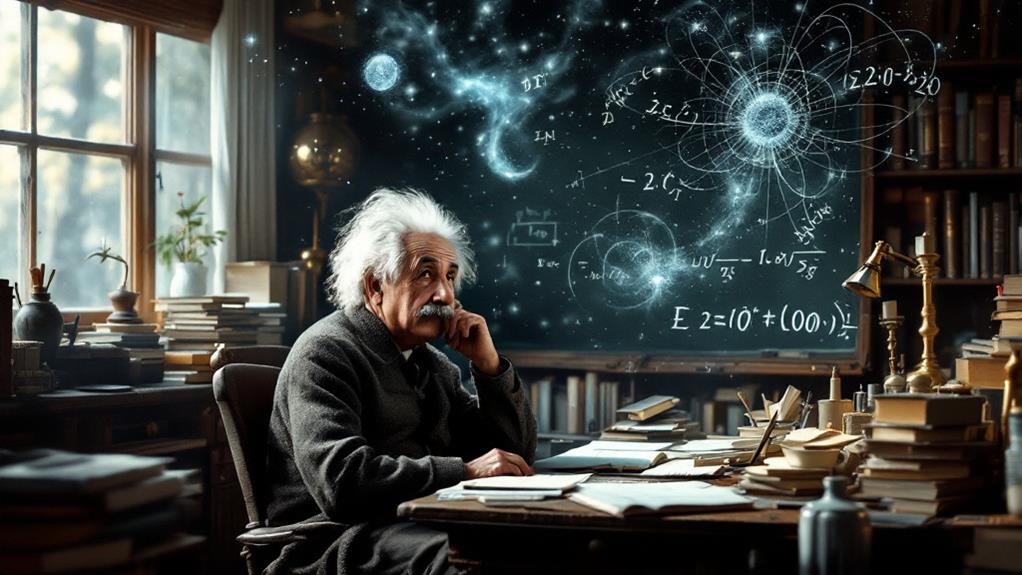
Often, Albert Einstein's curious thought experiments served as the backbone for his groundbreaking scientific theories. By imagining scenarios that defied conventional experiences, Einstein investigated the very nature of reality. These thought experiments weren't just mental exercises; they carried profound philosophical implications that challenged existing scientific paradigms and opened up new avenues of inquiry.
Picture this: you're riding alongside a beam of light, witnessing time slow and space distort. Such vivid imagery helped Einstein conceptualize his theory of relativity, reshaping how we comprehend time and space. Through these mental scenarios, he could test hypotheses without a physical laboratory.
Consider the following thought experiments and their implications:
- Riding a Light Beam: Challenges the classical concepts of speed and time.
- Elevator in Free Fall: Investigates gravity and acceleration equivalence.
- Twin Paradox: Raises questions about time dilation and aging.
- EPR Paradox: Examines quantum entanglement and locality.
- Bouncing Light in Trains: Illustrates the relativity of simultaneity.
Each experiment invites you to question your perceptions and the universe's fundamental nature. By engaging with these thought experiments, you bridge the gap between tangible reality and abstract theory, much like Einstein did in his revolutionary work.
Relationship With Religion
Throughout his life, Albert Einstein's relationship with religion intrigued many people. You might think that a scientist of his caliber would dismiss religion entirely, but Einstein's views were more nuanced. He often found himself maneuvering the complex tension between faith vs. science. While he didn't subscribe to any organized religion, he wasn't an atheist either. Instead, Einstein described himself as agnostic, often referring to a sense of wonder and mystery about the universe that bordered on spiritual beliefs.
Einstein believed in a harmonious relationship between science and spirituality. He famously said, "Science without religion is lame, religion without science is blind." This statement reflects his belief that the universe's intricacies could inspire a sense of spirituality, even if he doubted traditional religious doctrines.
For Einstein, the pursuit of scientific understanding didn't negate a sense of awe in the face of the universe's mysteries. His spiritual beliefs were rooted in the idea that there might be something greater, a cosmic order, even if it couldn't be fully understood or explained by human minds. This unique perspective made Einstein's relationship with religion as fascinating as his scientific achievements.
Founding the Hebrew University

Einstein's sense of wonder and belief in a cosmic order also found expression in his dedication to education and cultural advancement. He played a crucial role in establishing the Hebrew University of Jerusalem. His commitment to Zionist advocacy and academic leadership was evident as he envisioned a center for Jewish learning and intellectual exchange. Einstein's involvement wasn't just honorary; he actively participated in planning and fundraising, understanding the university's potential impact on both Jewish and global scholarship.
As you examine Einstein's role, consider these key points:
- Visionary Contributor: Einstein saw the university as a lighthouse for Jewish intellectualism and a hub for scientific progress.
- Fundraising Efforts: He traveled extensively to gather support and funds, demonstrating his deep commitment to the cause.
- Academic Leadership: Einstein's influence helped shape the university's mission and attract leading scholars.
- Zionist Advocacy: His support aligned with his broader efforts to advance Jewish cultural and educational causes.
- Inaugural Address: Einstein delivered a speech at the university's opening, highlighting its importance to global education.
Einstein's efforts with the Hebrew University left a lasting legacy, underscoring his belief in the power of education to transform societies.
Brain Preservation Controversy
Remarkably, the story of Albert Einstein's brain after his death is as intriguing as his life. When Einstein passed away in 1955, the pathologist Thomas Stoltz Harvey removed his brain during the autopsy, hoping to uncover secrets of his genius. However, Harvey's decision ignited the brain preservation ethics debate, as he hadn't obtained permission from Einstein or his family. For decades, Harvey kept the brain, sometimes sending pieces to researchers. This act raised questions about the moral implications of using a person's remains for scientific study without consent.
You might wonder about the neuroscience implications of Harvey's actions. By investigating Einstein's brain, scientists hoped to find physical explanations for his extraordinary intelligence. Some studies claimed differences in his brain's structure, potentially related to his cognitive abilities. However, these findings remain controversial, partly because of the ethical issues surrounding the brain's acquisition and the small sample size.
The controversy highlights the delicate balance between scientific curiosity and respect for individual autonomy. As you examine these ethical and scientific dimensions, consider how Einstein's mind continues to challenge our understanding of both the universe and the limits of ethical research practices.
His Legacy in Pop Culture
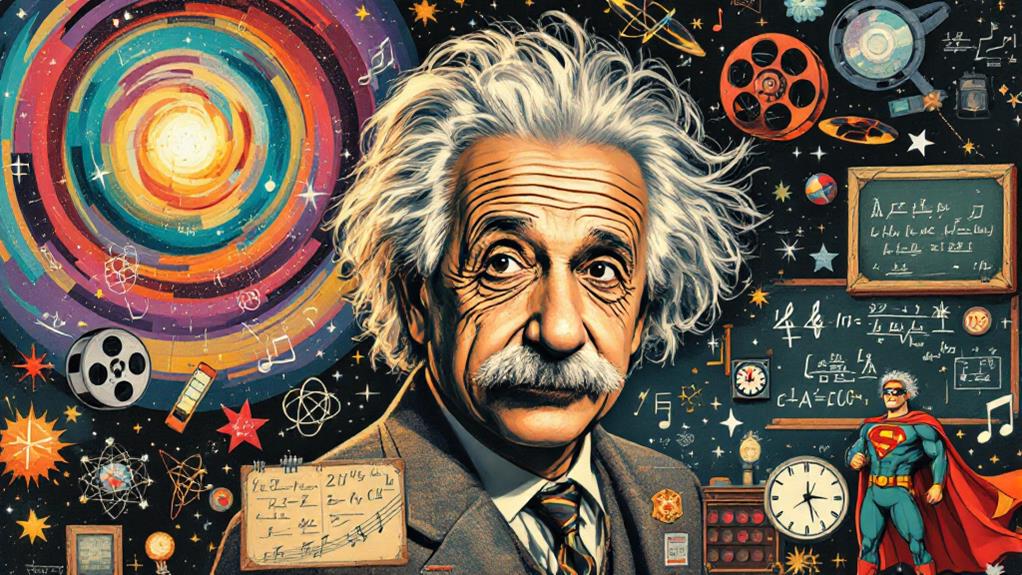
Albert Einstein's influence extends far beyond the domain of science, permeating popular culture in countless ways. You've likely come across his iconic image—wild hair, piercing eyes, and thoughtful expression—engrained in countless contexts. His likeness has become a universal symbol of genius, often featured in Einstein memes that humorously juxtapose complex ideas with his famous face. These memes have solidified his status as a relatable figure, bridging the gap between high-level science and everyday life.
Einstein's presence in movies further cements his cultural impact. He's been portrayed in several films that investigate his life, achievements, and the challenges he faced. These movies not only celebrate his scientific contributions but also humanize him, showcasing his quirks and idiosyncrasies. His character often embodies the quintessential "mad scientist" trope, yet he's always portrayed with respect and admiration.
In popular culture, Einstein has become more than a historical figure; he's an archetype. His legacy is evident in:
- Einstein memes that blend humor with intellect.
- Einstein movies that highlight his life.
- References in music, celebrating his genius.
- Appearances in TV shows as a symbol of brilliance.
- Inspiration for characters in literature and art.
His image and ideas continue to inspire creativity worldwide.
Einstein's Timeless Influence
The enduring power of Einstein's ideas continues to shape our world, transcending the boundaries of time and geography. His theories, especially relativity, have fundamentally altered how you understand the universe. Einstein didn't just revolutionize physics; he also inspired a culture of scientific collaboration and mentorship that persists today. By encouraging open dialogue and the sharing of ideas, he created an environment where innovation thrives.
When you think of Einstein's mentorship, consider how he guided young scientists. He offered advice and support, fostering new generations of thinkers who expanded on his groundbreaking work. This spirit of mentorship guarantees that the pursuit of knowledge remains a collaborative effort. You see this in modern scientific communities where collaboration across disciplines leads to breakthroughs unimaginable in Einstein's time.
Einstein's timeless influence is evident in technology, too. GPS systems, for instance, rely on principles from his theories to provide accurate location data. His ideas continue to drive innovations that improve your daily life. Whenever you witness a scientific achievement today, you're seeing a piece of Einstein's legacy. His influence is a demonstration of the power of curiosity and collaboration, reminding you that great ideas know no temporal limits.
